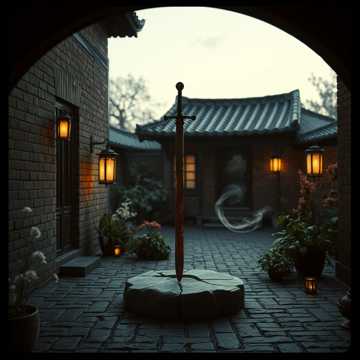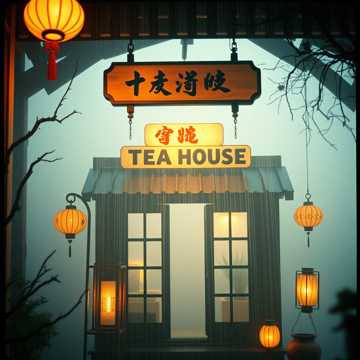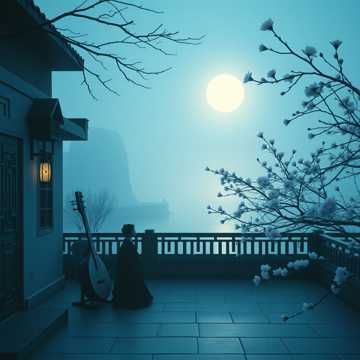
Free Chinese Folk Music Generator Powered by AI
Turn text into high-quality Chinese Folk music effortlessly – no login required!
music.toolTips

Pe cărarea munților — 中国浪漫民谣版
A gentle Chinese folk ballad evoking peace and serenity, featuring intimate vocals, delicate flute, and soothing strings, generated by Suno AI.
02:57
9 hours ago

案上春秋
A nostalgic folk ballad about guidance, loss, and self-discovery, where an elder imparts wisdom to a younger disciple, framed through intimate melodies and rich, evocative lyrics.
04:29
12 hours ago

《芙蓉·拒霜》
《芙蓉·拒霜》 is a contemplative Chinese song that celebrates the resilience and beauty of the lotus flower, with lyrics steeped in historical and cultural references, while blending traditional regional styles of Sichuan and Hunan. Its message emphasizes life's enduring wisdom and strength.
04:55
20 hours ago

《栀子·同心》
以栀子花为媒介,串联屈原文化、青春记忆与爱情纯洁,呈现古今交融、情意绵长的端午主题歌曲。
04:33
20 hours ago

《石榴·多子》
‘石榴·多子’ is a joyful song celebrating unity, prosperity, and cultural heritage, symbolized by the pomegranate flower. Its festive melody, rooted in Northwest folk traditions, emphasizes family, nation-building, and the blessings of togetherness.
04:10
22 hours ago

《醉侠行》
‘醉侠行’ portrays the life of a disillusioned wandering swordsman, combining Chinese folk elements with rap to express themes of pride, rebellion, and the passage of time in a vividly rich soundscape.
06:40
2 days ago

热血快板行
A high-energy, instrumental folk-fusion piece with brisk percussion, agile woodwinds, and plucked strings. It builds through layers, culminating in a triumphant finale, ideal for intense, dramatic performances.
02:58
Invalid date

烟雨小茶馆
A lively Chinese folk instrumental that blends playful dizi melodies with festive drumming, guzheng, and pipa. The arrangement starts intimate and light, building into a bustling mid-section before returning to a warm, satisfied ending.
02:12
2 days ago

炎黄清风
A calming instrumental piece with a gentle flow, blending traditional Chinese folk instruments like xiao flute, guqin, and ruan. The composition swells slightly in the middle before fading into peaceful tranquility, evoking a sense of natural harmony.
04:11
2 days ago

云水一程
A serene, instrumental Chinese folk-ballad blending traditional pipa and bamboo flutes, with light percussion and subtle guzheng pads, evoking a sense of deep emotion and tranquility.
03:43
3 days ago

炎黄欢歌
以轻快民乐与层层对位构筑节庆氛围,展现明亮、热烈且充满民族色彩的欢庆之舞。
03:47
3 days ago

三境行
A reflective song blending traditional wisdom with modern sound, focusing on personal growth, self-cultivation, and spiritual journey. Its melodic beauty and powerful vocals evoke a sense of determination and peace.
04:00
Invalid date

青年队
A vibrant, nostalgic tribute to youth and rural life, '青年队' blends Chinese folk elements with pop rhythms, evoking memories of simpler times and the spirit of youthful dreams under the moonlight.
04:20
4 days ago

高老庄炊烟
A melancholic, cinematic rap about transformation, destiny, and inner conflict, blending Chinese folklore with modern beats. The song tells the story of a character’s fall from grace and their ongoing journey toward redemption, caught between myth and reality.
03:08
4 days ago

高家岔
A musical journey through the vivid imagery of rural life in the highlands, blending EDM and traditional Chinese instruments, evoking nostalgia, warmth, and pride for one's homeland.
07:38
4 days ago

长河映月
A poetic song blending ancient Chinese folk elements and emotional depth, narrating a timeless love story through vivid imagery and rich instrumental harmonies.
03:26
5 days ago

苦缘
A melancholic exploration of unrequited love and destiny, '苦缘' weaves together classical Chinese poetic elements with modern storytelling, delivering a deeply emotional journey through heartbreak and longing.
06:10
5 days ago

葛根汤之歌
A traditional Chinese folk song celebrating the healing properties of葛根汤, a herbal remedy. The lyrics express warmth and relief from ailments like cold and muscle tension, with a gentle, soothing melody that enhances the healing theme.
02:51
5 days ago

月下故人
A melancholic folk ballad reflecting on lost love, separation, and the passage of time, with a delicate, moonlit atmosphere. Traditional Chinese instruments enrich its emotional depth and introspective tone.
02:55
5 days ago

《菊花·隐逸》
A reflection on solitude and resilience, '菊花·隐逸' combines imagery of chrysanthemums, autumn, and historical references, weaving a narrative of retreat and inner peace, set to a tranquil folk melody.
04:25
5 days ago
Introduction to the Chinese Folk Music Tag
Chinese Folk, a vital subgenre of traditional Chinese music, refers to the music of the common people that has been passed down orally for generations across various regions of China. Chinese Folk music has deep historical roots, dating back over 3,000 years, and reflects the unique cultural, linguistic, and geographic diversity of China's vast landscape. Originating from ancient agricultural societies, Chinese Folk was initially used to express emotions, tell stories, celebrate festivals, and record historical events. It evolved through dynasties, heavily influenced by Confucianism, Taoism, and Buddhism, and developed regional characteristics and distinctive performance styles. Today, Chinese Folk continues to thrive both in its traditional forms and modern reinterpretations, preserving cultural heritage while adapting to contemporary audiences.
Sub-tags and Classifications of Chinese Folk Music
Northern Folk
Northern Folk music features bold andChinese Folk Music SEO resonant vocal techniques, often accompanied by traditional instruments like the suona and the erhu. It is rooted in the musical traditions of northern provinces such as Shanxi, Hebei, and Inner Mongolia, and typically reflects themes of heroism, farming life, and the majestic natural environment.
Southern Folk
Southern Folk music, prevalent in regions like Jiangnan, Fujian, and Guangdong, is known for its soft melodies and lyrical finesse. It frequently utilizes instruments like the pipa and guzheng. Southern Folk songs often explore themes of love, daily life, and poetic imagery from nature.
Ethnic Minority Folk
This sub-tag includes the music of China's 55 officially recognized ethnic minorities, such as the Zhuang, Tibetan, Uighur, and Miao peoples. Each ethnic group contributes unique scales, rhythms, and instruments, creating a rich mosaic of Chinese Folk music with distinctive cultural signatures.
Mountain Songs (Shan'ge)
Shan'ge are antiphonal songs traditionally sung in mountainous rural areas, used as a means of courtship or social interaction. Famous in regions like Guangxi and Hunan, Shan'ge are characterized by improvisational lyrics and strong regional dialects.
Work Songs (Laogongge)
Work Songs are rhythmic chants and melodies sung during labor, such as farming, fishing, or weaving. These songs often follow a call-and-response structure and are tightly synchronized with the rhythm of the work being performed.
Famous Artists and Works in Chinese Folk Music
Li Na (李娜)
Li Na is a prominent singer known for modern interpretations of traditional Chinese Folk music. Her song 'Qingzang Gaoyuan' (Tibetan Plateau) brought ethnic folk elements to the mainstream, bridging traditional roots with modern aesthetics.
Jasmine Flower (茉莉花)
A timeless folk song originating from Jiangsu province, 'Jasmine Flower' features gentle, flowing melodies and poetic lyrics that praise the delicate beauty of jasmine blossoms. It is widely recognized for its elegance and has been adapted in various international settings, including opera and film.
Song Zuying (宋祖英)
Song Zuying is one of the most celebrated Chinese Folk sopranos, renowned for her performances of Miao and Han folk songs. Her works like 'Love My China' and 'Spicy Girl' exemplify vocal mastery and patriotic themes in folk music.
The Moon Represents My Heart (月亮代表我的心)
Though often categorized as Mandopop, this song by Teresa Teng draws heavily from folk sensibilities, with its simple melody and heartfelt lyrics. It exemplifies how folk elements permeate Chinese popular music and has become a symbol of sentimental Chinese culture.
Wang Kun (王昆)
Wang Kun was a pioneer in the popularization of Chinese Folk music during the mid-20th century. As a leading performer and educator, she played a crucial role in blending folk styles with revolutionary and patriotic content.
The Shepherd's Song (牧羊曲)
Popularized by the film 'Shaolin Temple', this folk-inspired piece uses traditional instrumentation and pastoral imagery to evoke a sense of nostalgia and harmony with nature, making it a beloved classic in Chinese cinematic music.
Tan Weiwei (谭维维)
Tan Weiwei blends rock with Chinese Folk motifs, especially from Tibet and Sichuan, creating a contemporary twist on traditional music. Her bold voice and cultural fusion reflect a modern revival of folk traditions.
Application Scenarios for Chinese Folk Music
Chinese Folk music is frequently used in historical dramas, fantasy epics, and documentaries to enhance cultural authenticity and emotional depth. For example, traditional folk melodies are often used in period dramas to evoke historical ambiance.
Film and Television Soundtracks
Brands use Chinese Folk music in advertising to evoke nostalgia, authenticity, and a connection to heritage. It is especially effective in campaigns promoting traditional foods, tourism, and cultural events.
Advertising and Commercials
In games set in ancient China or mythical settings, Chinese Folk music enhances the immersive experience. Games like 'GuJian' and 'Justice Online' incorporate regional instruments and folk motifs in their soundtracks.
Video Game Background Music
Chinese Folk music is a staple in performances during Lunar New Year, Lantern Festival, and regional cultural festivals. It serves to reinforce cultural identity and celebrate communal traditions.
Cultural Events and Festivals
Chinese Folk music is used in multimedia displays and educational programs to provide cultural context and enhance the storytelling of traditional Chinese lifestyles and practices.
Educational and Museum Exhibits